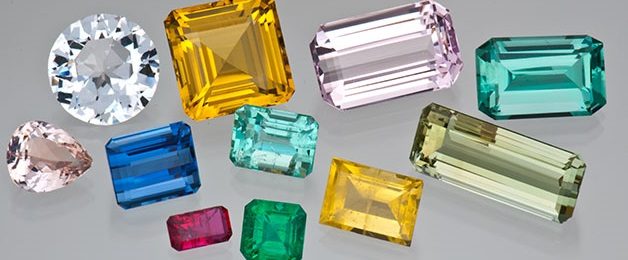I have a great desire to discover the history, nature, secrets, mysteries and treasures of civilisation. A passion transmitted and cultivated since childhood. Topkapi Palace was one of the first trips to fascinate and imprint in my memory and soul. This is the story of the Treasures of Istanbul.
The Topkapi is a treasure guarded in one of the most magical and beautiful cities in the world. A natural spectacle: washed by the sea and warmed by a blazing sun, with thousands of years of history. It is in the West but also in the East. A crossroads of peoples, religions and civilisations has helped to make this city rich in precious treasures. This is Istanbul. Byzantium, an ancient Greek city, became the capital of the Byzantine Empire, which scholars used to define the Eastern Roman Empire.
Constantine Constantinople chose the territory on which the ancient Greek city stood, to build the new capital, because of its strategic location, Constantinople was completed in 330.
The Roman Empire ceased to exist under the conquest of the Ottoman Turks, which was the longest Empire in Europe history.
So there was a radical change for the city, which partially destroyed by sieges, was rebuilt. All the religious buildings were converted into mosques. Constantinople saw a period of splendour under the Ottoman sultans, the caliphate in 1517 held the seat of the Greek-orthodox patriarchy and saw the construction of the magnificent Topkapi complex. Only after the First World War, was the Ottoman empire defeated and the capital of Turkey moved from Istanbul to Ankara.
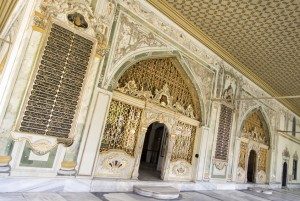
Topkapi Imperial Palace
The visit to the Topkapi Palace is among the most beautiful memories of this intense and adventurous journey, perhaps because my travelling companions were and still are among the people most dear to me, perhaps because it was the first of a wonderful series, perhaps because it is among the memories of the summers of a still carefree age.
Istanbul is situated on the banks of the Bosphorus, the strait that separates Asia and Europe, is the largest urban centre in Turkey and remains a busy city and full of magic. Built in 1453, following the capture of Constantinople by Mehmet the Conqueror, the Imperial Palace was the centre of the Ottoman Empire for four centuries. It was home to as many as 26 of the 36 sultans of the Ottoman Empire until moving to the Palace of Dolmahbace.
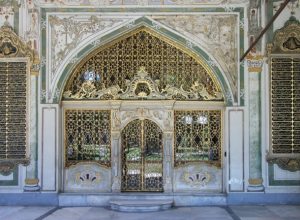
Topkapi Treasury – gold, enamel and pearl
Topkapi is located on the top of of the Seraglio between the Golden Horn and the Sea of Marmara. In Turkish Topkapi literally means Port of Cannon and derives its name precisely from one of the doors that allowed the access to the complex. Along with other historical areas of the city, Topkapi was inscribed on the List of UNESCO World Heritage since 1985. The structure of the building is quite complex, with small buildings built all around the courtyards connected by galleries and passages. Generally the buildings have one floor and in its heyday the complex accommodated up to 4000 people. The palace has hundreds of rooms, in which Ottoman architecture symbols and collections of all kinds: from the porcelain, Islamic manuscripts, weapons, up to jewellery, clothing and precious treasures are preserved.
Richly decorated with precious and treasures, Topkapi has a rectangular plan consisting of four courtyards and a harem.
The first court acts as entrance to the palace; the second is the court of the ceremonies, the State Treasury which contains a display of weapons; in the third court contains: a library, a mosque, sacred relics, collections of treasures and the entrance to what was once a forbidden zone, or the Harem; the fourth, with the amazing views of the Bosphorus strait, was the most hidden.
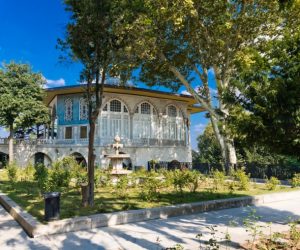
Topkapi Palace Harem apartments
One of the most fascinating places and is definitely not to be missed is the Harem, which literally means “prohibited place” and that was the place of legends and court intrigues.
In reality the Harem was the private part of the house. Composed internally of more courts, Lodging, secret tunnels, rooms, fountains, gardens overlooking the sea, “l’harem” was a wing of the building dedicated to the sultan’s women and it consisted of 300 rooms, 8 bathrooms, 4 kitchens, 2 mosques, 6 cellars, a pool and an infirmary. At one time about a thousand women cohabited here, including the queen mother, the favourite of the Sultan, but also former favourite that had given him a son, maids, nurses, dressmakers, musicians, dancers and female slaves, guarded by eunuchs, who were the only men allowed in this part of Palace.
The Treasury of the Topkapı Palace is one of the most famous treasures in the world! It is distributed in four rooms and its origins include gifts from other rulers, inheritance and spoils of war. In the rooms you can admire a large number of furniture, furnishings, decorative items, pendants, daggers, chests, books, jewellery, rings, all exquisitely decorated with precious stones: emeralds, diamonds, rubies, crystals, turquoise and other precious and semi-precious stones. All of the treasuries objects are precious, having belonged to kings and surviving time. Solid gold candlesticks set with 6666 diamonds, the throne covered in gold leaf, the famous Topkapi Emerald dagger, which is the most expensive in the world, made with diamonds (one the world’s third largest), gold and emeralds , and finally the Spoonmaker’s Diamond.
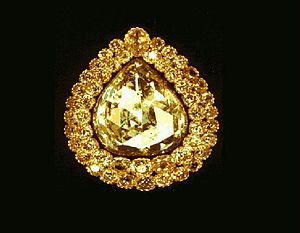
The Spoonmakers’ Diamond photo: Harry Gouvas /Wikipedia
It is a stone weighing 86 carats (17 g) placed inside a double frame of 49 bright, it said to have been arranged by Ali Pasha or by Sultan Mahmud II to give the impression of a full moon in middle of a sky full of stars, as well as has been observed by many scholars.
The second one of the origin myths of Spoonmaker’s Diamond, is that a poor fisherman wandered without a penny empty handed around in Istanbul, he finds a polished stone in the trash. Unsure of its real value, but admiring the splendour, went to the markets looking for a buyer. An expert jeweller, with insincere disinterest, tells the fisherman it was just a piece of glass and exchanges three tablespoons for the stone! Another slightly different version from the same legend, was about Rashid, a very poor man, who finds the diamond in 1699 while rummaging in garbage dumps in Istanbul. Dealing with a merchant, he managed to get three wooden spoons in exchange for this polished stone.
The Merchant of spoons, recognising the gem as valuable, but not realising it was worth a fortune, he sold it to a jeweller for ten silver coins. After changing a number of hands, the diamond was confiscated by the Grand Vizier Ahmed Pasha and soon passed into the hands of Sultan Mehmed IV. Another researchers and historians, was a French officer named Pigot purchased the diamond in 1774 from the Maharajah of Madras and took it with him in France. But during his trip he was robbed and exposed for many purposes diamond auctions, where it was first bought by Casanova and then by Napoleon’s mother, who was forced to put it on sale to save her son when Napoleon was exiled. It seems that to buy it was a man at the service Ali Pasha of Ioannina, who later, during the reign of Mahmud II, then was killed on charges of rebellion and treason. His treasury, including the Pigot Diamond, was confiscated by the State. still uncertain if the Diamond of spoons handler was worked with forty diamonds from men of Mahmud II, or of men of Ali Pasha of Ioannina, but what is indisputable is that they increase his glancing and its market value.
The Topkapi Emerald Dagger, an item of exquisite craftsmanship was actually one of the many precious gifts, of the embassy of Sultan Mahmud I (1730-1754) in Iran, he was supposed to bring a gift to the Iranian conqueror Nadir Shah, but which unfortunately never happened because Nadir was assassinated. The gifts, Including the jewel-encrusted dagger was returned to the treasure of Istanbul and in the Museum of Topkapi Palace. The popularity of the dagger, as well as the museum which keeps it, had great resonance in the world, when it played the protagonists of a popular Hollywood movie “Topkapi” in 1964, based on Eric Ambler’s novel “The Light of Day”.
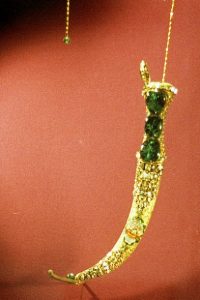
The Topkapi Emerald Dagger
The Topkapi Emerald Dagger has three are great emeralds with deep colour, good clarity and transparency, mounted on the handle. The upper and lower emeralds have an identical pear-shaped cut, with the pointed ends facing each other. The central emerald is a cushion cut. The emeralds are interspersed with small diamonds placed at the four corners of the rectangle in the centre and the four corners of the trapezoid are located above and below the rectangle. At the end of the handle there is an octagonal emerald, set up as a cover, which when opened reveals a small clock. Around this cover and the sides of the handle are smaller diamonds, the smallest on the dagger. The back of the neck is covered in enamel and mother of Pearl. The Dagger length is about 35 cm, including the handle. The curved blade reaches a little over two thirds of its length, over which glides the sheath. The sheath is made of gold with enamel floral motifs and set with diamonds. The enamel at the centre of the sheath is the design of a bouquet of flowers in a vase. The diamonds on the sheath also form a pattern on both sides of the floral enamelling, one towards the base and the other toward the tip of the sheath. The design of diamonds at the base of the sheath consists of 31 diamonds, mostly of rectangular shape arranged in a symmetrical pattern. The other design of diamonds towards the tip of the sheath is composed of 21 diamonds, arranged symmetrically as well. On the tip of the sheath is a large complex of emeralds. A gold chain encrusted with diamonds is tied to the handle of this wonder of the art of the goldsmith. The dagger, gems and the sheath represent a masterpiece of the highest artistic tradition of the Ottoman Empire, which reached a great refinement in the seventeenth century.
We too love gemstones and gold at Rocks& Co. Please Check out the opulence the we have on offer.

